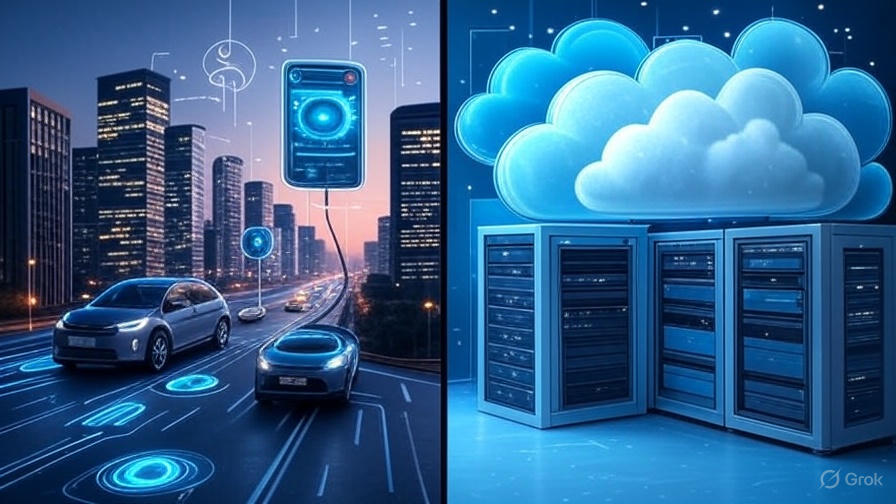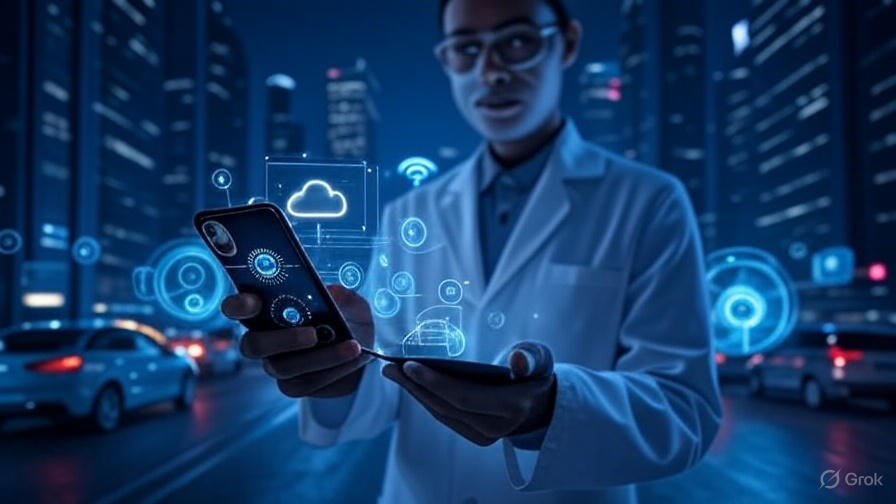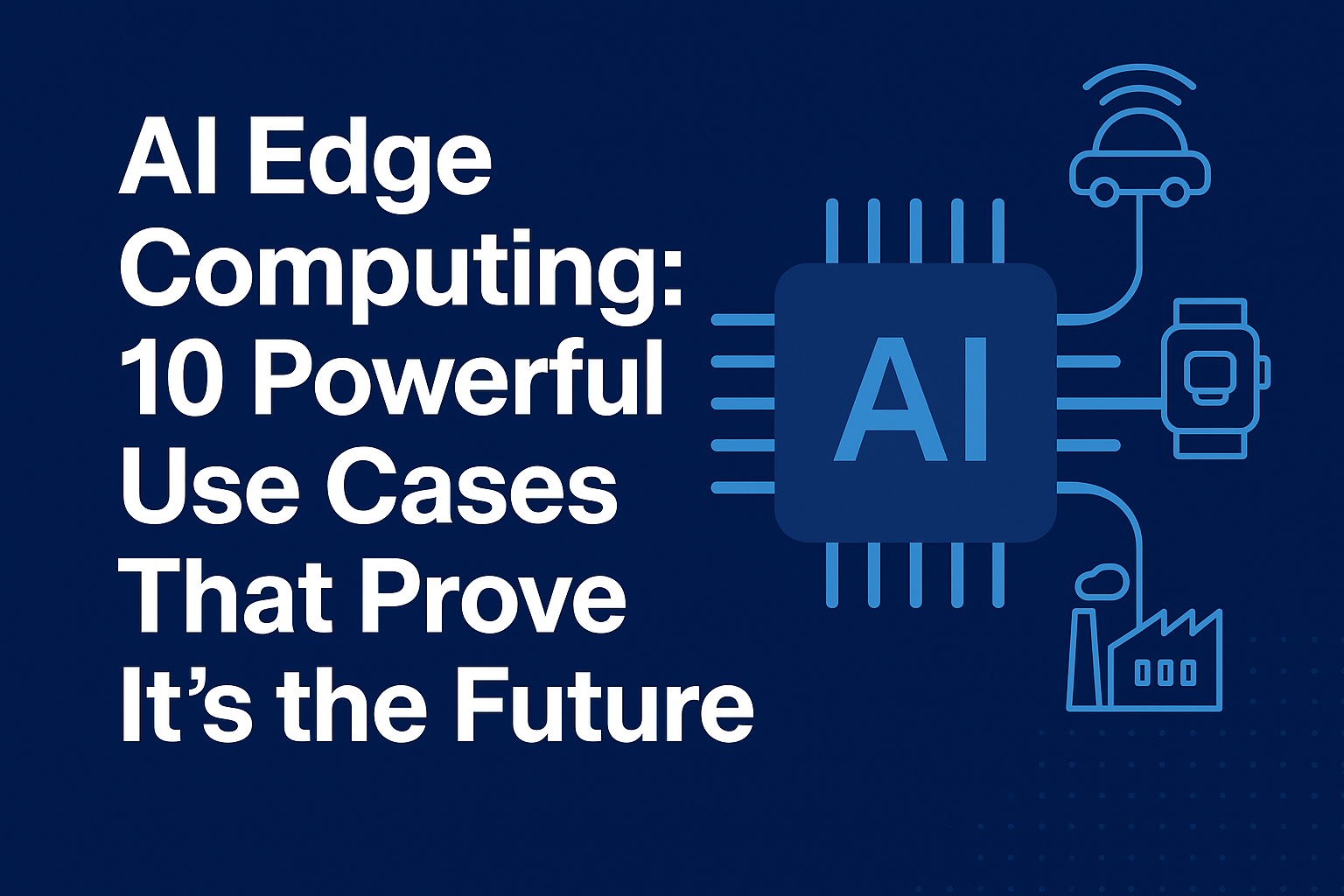Introduction: The Power of AI Without the Cloud
Imagine your smart car predicting traffic in real-time before you hit the freeway — no cloud, no internet, no delay. That’s not science fiction. That’s AI edge computing.
AI edge computing merges the intelligence of artificial intelligence with the agility of edge devices. It’s changing how data is processed, analyzed, and acted upon across industries. In this guide, you’ll learn what AI edge computing really is, why it’s revolutionizing real-time decisions, and how it’s already driving innovation.
In today’s hyper-connected world, milliseconds matter. Whether it’s autonomous vehicles avoiding accidents, factories preventing equipment failure, or smart cameras detecting threats in real time, decisions must be made instantly — often without relying on distant cloud servers. AI edge computing solves this by bringing intelligence directly to the source of data, enabling lightning-fast analysis with minimal latency.
Unlike traditional cloud-based AI systems, AI edge computing allows devices to function independently — even in remote or low-connectivity environments. This decentralization not only improves speed but also enhances data privacy, reduces bandwidth costs, and increases operational reliability.
From healthcare wearables delivering immediate diagnostics to retail systems optimizing shelf restocking in real time, AI edge computing is becoming the backbone of mission-critical systems. It’s not just an evolution in technology; it’s a fundamental shift in how and where AI works.
As industries race toward smarter, faster, and more secure systems, AI edge computing will be the edge that separates leaders from laggards.
AI edge computing is rapidly reshaping industries by enabling real-time data processing directly on devices, without relying on cloud servers. This technology powers faster decisions, improved privacy, and greater reliability across many applications. Here are 10 powerful use cases that prove AI edge computing is the future:
- Autonomous Vehicles: Real-time processing of sensor data for immediate decision-making without relying on cloud connectivity.
- Smart Cities: Edge AI powers traffic management, public safety monitoring, and energy-efficient street lighting by analyzing data locally.
- Healthcare Wearables: Instant health monitoring and diagnostics on devices like smartwatches without latency or privacy risks.
- Industrial Automation: Predictive maintenance and quality control using AI-enabled robots and sensors directly on factory floors.
- Retail Analytics: Real-time inventory tracking, customer behavior analysis, and personalized in-store experiences without constant cloud access.
- Agriculture: Edge AI analyzes soil conditions, weather, and crop health on-site to optimize farming operations and reduce waste.
- Smart Surveillance: Local video analytics for faster threat detection and privacy-preserving monitoring in public spaces.
- Telecommunications: Edge computing accelerates network optimization and manages 5G data streams with minimal delay.
- Energy Management: AI at the edge controls smart grids and renewable energy systems to optimize power distribution instantly.
- Augmented Reality (AR) & Virtual Reality (VR): Low-latency processing at the edge enables seamless immersive experiences for gaming and training.
What Is AI Edge Computing?

AI edge computing is the deployment of artificial intelligence models directly on edge devices like smartphones, IoT sensors, routers, and microcontrollers. Instead of sending data to a centralized cloud server, the device itself performs computations locally.
Key Components:
- Edge Devices: Hardware that collects and processes data
(e.g., drones, wearables, industrial robots, surveillance cameras) - Embedded AI Models: Pre-trained or on-device machine learning models optimized for low power and real-time execution
- Connectivity: Local communication between devices and optional cloud sync for storage, updates, or coordination
Difference From Cloud-Based AI:
While traditional cloud AI relies on high-bandwidth internet connections to offload data to powerful remote servers, AI edge computing processes information on-site. This reduces:
- Latency
- Bandwidth usage
- Cloud dependency
- Security vulnerabilities
Benefits of AI Edge Computing:
- ⚡ Real-Time Decision-Making: Instant analysis with no delay, crucial for applications like autonomous vehicles and industrial automation
- 🔐 Improved Data Privacy: Sensitive data stays local, reducing exposure
- 📶 Works in Low-Connectivity Areas: Ideal for rural, remote, or disconnected environments
- 💸 Cost-Effective: Minimizes cloud storage and data transfer costs
- 🌱 Energy Efficient: Many edge devices are optimized for low power consumption
By enabling local intelligence, AI edge computing allows systems to become faster, smarter, and more resilient. Whether in smart homes, agriculture, or manufacturing, AI edge computing is the key to next-gen, autonomous decision-making.
The Architecture of AI at the Edge
A typical edge AI architecture includes:
- Data Capture Layer: Sensors and cameras collecting raw input
- Processing Layer: On-device AI inference using chips like NVIDIA Jetson or Google Coral
- Application Layer: User interface, alerts, or mechanical actions triggered by AI outputs
- Cloud Layer (Optional): Periodic syncing, retraining, or logging to central servers
Visual Suggestion: Add a system diagram comparing edge vs. cloud AI workflows.
Top Benefits of AI Edge Computing

Ultra-Low Latency: Decisions can be made within milliseconds without depending on network speed. This is essential for critical applications like self-driving cars or robotic surgeries.
Reduced Bandwidth Costs: By processing data locally, only important summaries or anomalies are sent to the cloud. This slashes data transfer expenses significantly.
Enhanced Privacy & Compliance: Personal data never leaves the device, ensuring compliance with regulations like GDPR and HIPAA.
Improved Reliability: Devices function even with limited or no internet access, enabling autonomous operation in remote areas.
Challenges of AI at the Edge
Despite its benefits, edge AI presents technical and logistical hurdles:
- Limited Compute Power: Edge devices must balance processing power with power efficiency.
- Model Optimization: AI models must be compressed using quantization or pruning to fit on smaller chips.
- Security Risks: Local devices are vulnerable to tampering or data breaches.
- Maintenance Complexity: Updating models across thousands of edge devices can be labor-intensive.
AI Edge Computing vs. Cloud AI: Which One Wins?

Use Edge AI When:
- Real-time decisions are required
- Network connectivity is limited
- Data privacy is a top concern
Use Cloud AI When:
- Large-scale data processing is needed
- Training complex models
- Centralized model management is preferred
Hybrid Approach: Many enterprises are now adopting a hybrid model — inference at the edge, training in the cloud.
Proven AI Edge Use Cases Transforming Industries
Smart Manufacturing: Industrial machines use edge AI to detect defects, predict failures, and optimize production in real time.
Autonomous Vehicles: Cars and drones use onboard AI for navigation, obstacle detection, and decision-making without needing to connect to the cloud.
Retail & Surveillance: Edge cameras in stores track footfall, customer engagement, and potential threats, all processed locally to ensure privacy.
Healthcare Diagnostics: Portable devices use edge AI to analyze vitals, detect diseases like pneumonia from X-rays, and provide instant feedback.
Precision Agriculture: Drones and smart sensors monitor soil, moisture, and crop health in real time, enabling micro-level farm optimization.
External Link: Read how edge computing is transforming agriculture in Deloitte’s Edge AI report.

Smart Cities Powered by Edge AI
Traffic Optimization: Cameras and sensors manage signals based on real-time congestion data.
Public Safety: Edge devices detect gunshots, unusual movement, or environmental hazards, and alert authorities instantly.
Utility Management: AI regulates power usage based on demand, weather, or population patterns to reduce waste.
Consumer Electronics with Built-In Edge AI
- Voice Assistants: Process commands locally for faster responses and improved privacy.
- Smart Cameras: Recognize faces, detect intruders, and differentiate between pets and humans.
- Wearables: Track fitness, heart rate, or sleep quality in real time without constant internet access.
Visual Suggestion: Add product image examples like Google Nest, Apple Watch, and Alexa with brief AI tasks.
Security and Governance in Edge AI Deployments
- Device-Level Encryption to protect data in transit and at rest
- Federated Learning to train AI models locally without exposing raw data
- Model Governance to ensure fairness, accuracy, and compliance across decentralized systems
Internal Link: Learn more about responsible model deployment in our AI Model Governance Guide.
Key Technologies Enabling AI at the Edge
Hardware Innovations:
- Google Coral Edge TPU
- NVIDIA Jetson Nano
- Intel Movidius VPU
Software Frameworks:
- TensorFlow Lite
- OpenVINO
- AWS Greengrass
Connectivity Infrastructure:
- 5G networks for rapid device-to-device communication
- IoT protocols like MQTT and CoAP
Real-World Case Studies
BMW uses edge AI for quality control, analyzing parts in milliseconds during assembly.
John Deere deploys smart sensors to monitor tractors and optimize farming conditions.
Stanford Medicine integrates AI diagnostics on portable devices for faster rural health support.
External Link: Market data from Statista shows the global AI edge computing market will surpass $60 billion by 2030.
The Future of AI Edge Computing
- Generative AI on Edge: Lightweight LLMs running offline
- Edge-to-Edge Collaboration: Devices coordinating without central cloud
- Autonomous Agents: Decentralized decision-making across supply chains, fleets, or homes
- Custom AI Chips: Purpose-built silicon for edge inference
Expect AI edge computing to lead the next evolution in automation, efficiency, and decentralization.
Real-World Momentum Behind AI Edge Computing
The rise of AI edge computing isn’t just theoretical — it’s already transforming operations across industries. For instance, manufacturers are embedding AI into edge-based robotics to optimize production lines in real time, while healthcare providers use wearable devices powered by AI to monitor vitals instantly without cloud dependency. According to McKinsey & Company, edge AI is a cornerstone of future-ready enterprise architecture, particularly for sectors demanding ultra-low latency and data security. Meanwhile, NVIDIA reports that edge platforms with integrated AI can increase inference performance by over 20× compared to cloud-dependent alternatives. Tech leaders like Microsoft Azure and IBM have also accelerated investments in edge AI infrastructure to support everything from smart cities to autonomous retail systems.
Related Insight: Shadow AI and Compliance Risks
While AI edge computing promotes real-time efficiency and localized control, it’s important to recognize how unsanctioned or unmonitored AI use — often called Shadow AI — poses operational and security risks. Many organizations unknowingly run AI tools on the edge without governance frameworks in place, increasing exposure to compliance violations and data leakage. If you want to dive deeper into how hidden AI tools are affecting enterprise environments, don’t miss our in-depth guide:
Shadow AI and Unapproved AI Tools – What You Should Know
Conclusion: Why Edge AI is a Business Imperative
Edge AI is no longer a niche technology. It’s a core enabler of real-time intelligence in industries, cities, homes, and devices.
Businesses must align their digital strategies with edge capabilities to gain operational advantages, enhance user experiences, and future-proof their infrastructure.
Found this helpful? Share this guide, comment below with your thoughts, or subscribe for more insights on AI, automation, and edge technologies.

